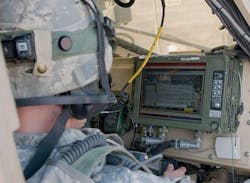Open-systems electronics standards for military embedded computing gaining money and traction
These standards are the Hardware Open Systems Technologies (HOST); Command, Control, Communications, Computers, Intelligence, surveillance and Reconnaissance (C4ISR) / Electronic Warfare (EW) Modular Open Suite of Standards (CMOSS); and Sensor Open System Architecture Standard (SOSA).
These three standards have broad support in the U.S. military services, and are being called out in military solicitations to industry, said Michael J. Hackert, a standards representative at U.S. Naval Air Systems Command at Patuxent River Naval Air Station, Md.
Hackert made his comments last week at the Embedded Tech Trends (ETT) conference in San Diego, which is sponsored by the VITA Open Standards and Open Markets industry trade group in Oklahoma City.
HOST, CMOSS, and SOSA "have acquisition dollars behind them," Hacker told conference attendees. By example, he says The F-35 joint strike fighter tech refresh 3 program is calling-out HOST standards, while U.S. Army Joint Battle Command–Platform (JBC-P) project is calling-out CMOSS embedded computing standards.
The JBC-P, the Army’s next-generation friendly force tracking system, is equipping soldiers with a fast satellite network, secure data encryption, and advanced logistics. Hackert says this program alone may involve about 125,000 separate Army platforms. A rough guess is that $75 billion in contracting opportunities involving CMOSS alone are available.
"It's the tip of the iceberg, and we are heading in that direction," Hackert told the ETT conference.
HOST saw its beginnings and initial support at Naval Air Systems Command. CMOSS, meanwhile, started at the Army Communications-Electronics Research, Development and Engineering Center (CERDEC) at Aberdeen Proving Ground, Md. Finally, SOSA was begun at the Air Force Life Cycle Management Center (AFLCMC) at Wright-Patterson Air Force Base, Ohio, and now comes under Aegis of The Open Group in San Francisco.
The HOST program seeks to decompose military embedded systems into functional blocks to ease system design and reuse of embedded computing hardware and software. It's intended to open systems for several different vendors and avoid locking single vendors into large system designs.
CMOSS is intended to move the embedded industry away from costly, complex, proprietary solutions and toward readily available, cost-effective, and open-architecture commercial off-the-shelf (COTS) technologies.
The SOSA project, meanwhile, focuses on single-board computers and how they can be integrated into sensor platforms, and involves a standardized approach on how embedded systems interrogate sensor data to distill actionable information.
Functionally, standards that the industry and the military services formulate under HOST, CMOSS, and The Future Airborne Capability Environment (FACE) Consortium initiatives will come under the umbrella of SOSA, which "is the overarching standard being developed," Hackert told the ETT conference.
For more information contact the VITA Embedded Tech Trends conference online at www.embeddedtechtrends.com.
Ready to make a purchase? Search the Military & Aerospace Electronics Buyer's Guide for companies, new products, press releases, and videos
